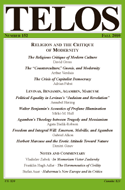From Telos 152 (Fall 2010), Mirko M. Hall’s “Dialectical Sonority: Walter Benjamin’s Acoustics of Profane Illumination.” Read the full version at TELOS Online website.
Abstract
 Given the extensive scholarship on Walter Benjamin, there exists a real scarcity of theoretical engagement with his views on acoustic phenomena. Yet throughout his critical writings, Benjamin displays a keen sensitivity to sound. In fact, he develops a concept of sound, which is equivalent—in its epistemological and metaphysical presuppositions—to the constitutive properties of the dialectical image: the aural thunderclap of sound parallels the visual lightning flash of the image.
Given the extensive scholarship on Walter Benjamin, there exists a real scarcity of theoretical engagement with his views on acoustic phenomena. Yet throughout his critical writings, Benjamin displays a keen sensitivity to sound. In fact, he develops a concept of sound, which is equivalent—in its epistemological and metaphysical presuppositions—to the constitutive properties of the dialectical image: the aural thunderclap of sound parallels the visual lightning flash of the image.
This article articulates a brief theory of Benjamin’s “dialectical sonority.” The dialectical sonority is an acoustic force field that is created through the crystallization of antithetical sonoric elements. It provides an analytical critique of acoustic power/knowledge constellations and resonates with the sounds of revolutionary historical consciousness. The dialectical sonority blasts acoustic phenomena out of the reified historical continuum and forges them into unexpected dialectical configurations of sound. These configurations expose the hidden aspects of sound’s relationship to everyday life—thus, interrogating the mechanisms of social control that are sustained by the ideological manipulation of sound. In other words, Benjamin helps us to hear culture as a powerful site of sonoric creativity, critique, and resistance.



